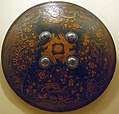Dhal (shield)
The dhal is a type of shield found in the Indian subcontinent.[1] They are nearly always geometrically round and yet they vary in diameter from about eight inches to twenty-four inches. Some are nearly flat while others are strongly convex or curved.[2] The edges may be flat or rolled back in the reverse direction to that of the curvature of the shield. Dhal shields were either made from metal or hide.[3]
Materials
Leather shields were made from a great variety of animals found in the Indian subcontinent. The hide shields were made from either water buffalo, sambar deer, Indian elephant, or Indian rhinoceros. The rhinoceros shields were the most prized variant among leather shields.[4] The earliest dhal shields, were formed of leather yet their popularity remained despite the emergence of other metal variants.
Metal shields were made from bronze, iron, and later with steel often made of wootz steel. They were usually inlaid with gold, silver, precious stones, and lac. The metal shields are lined with cloths embroidered with colors such as velvet, gold, or silver. The shields were further decorated through chiseling, gilding, painting. Metal crafting in India, including dhal shields, were crafted and fashioned in regional styles such as Bidriware.
The four metal bosses are often ornamental, either making use of their geometric shape alone, or through inlaying with gold, silver and jewels. The metal bosses also served as attachments for spikes which could be used offensively along with parrying blows.
Construction

The dhal is held by two handles fastened to ring bolts that pass through the shield and are riveted to bosses on the outside. Between the handles is a square cushion for the knuckles to rest against. The handles are so placed that, when tightly grasped, they force the backs of the fingers against the cushion giving a very firm and comfortable hold. Some Indo-Persian shields have three handles, two placed at the center as usual, and the third near the edge. The arm can be passed through the third loop and the center handles held in the hand; or it can be held by the center handles only.
References
- Sristidhar Dutta; Byomakesh Tripathy (2006). Martial Traditions of North East India. Concept Publishing Company. pp. 97–. ISBN 978-81-8069-335-9.
- Cameron Stone, George (1961). A GLOSSARY of the Construction, Decoration and Use of Arms and Armor IN ALL COUNTRIES AND IN ALL TIMES Together with Some Closely Related Subjects. Jack Brussel. p. 206.
- DK (2011-08-15). DK Eyewitness Books: Arms and Armor: Discover the Story of Weapons and Armor—from Stone Age Axes to the Battle Gear of the Samurai. Penguin. ISBN 978-0-7566-8951-3.
- Ciuk, Krzysztof; Woodward, Susan. "Shields of dreams: Mughal dhals sport "designer label" rhino". ROM: Magazine of the Royal Ontario Museum; Toronto. 34: 5 – via ProQuest.
External links
| Wikimedia Commons has media related to Dhal. |
- Horsham Museum website with collections database access